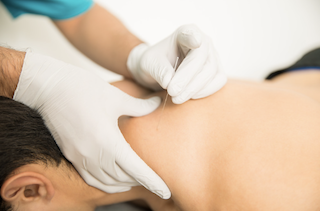Physio Hub:
Evidence-Based Article
What is Dry Needling?
~ Does It Really Work? ~
You may have heard of Dry Needling, an increasingly popular treatment method in the realm of health, fitness, and rehabilitation that has been gaining recognition in recent years. This specialized technique targets specific muscle, neural, or connective tissues in the body via the insertion of thin, solid needles into the desired tissues. Unlike injections, no substance is delivered; the procedure aims solely to relieve tension, reduce pain, and enhance movement through direct physical stimulation. The use of Dry Needling has been the subject of increasing research, and its efficacy has been shown for many different populations, making it a suitable choice for many individuals.
What’s the Difference between Dry Needling and Acupuncture?
To answer this common question, we must first understand the core of both practices. Dry Needling involves the insertion of a thin needle into a myofascial trigger point to relieve pain and improve range of motion. It is rooted in a field of pain science, known as the radiculopathy and trigger point model, which has been supported by evidence for many years (Dommerholt, 2006; Dommerholt, 2011). In contrast, Acupuncture, as described by Meakins (2016), involves the insertion of fine filament needles at specific points on the body’s ‘meridians’ to restore the flow of energy, known as ‘Qi’. This traditional Eastern practice has been used for thousands of years to treat various conditions, particularly musculoskeletal pain (Pyne, 2008).
To summarize, the primary distinction between these practices lies in their theoretical foundations and main objectives: dry needling is focused on alleviating local muscle tension and pain, whereas acupuncture aims to balance the body’s overall energy flow.
What are the effects of Dry Needling?
As the research supporting dry needling grows, so do its reported applications. Increases in microcirculation, nerve conduction velocity, collagen proliferation, local oxygen saturation, joint range of motion, muscular strength, as well as short-term pain reduction have all been demonstrated with dry needling (Dunning, 2014; Zhou K, 2015). Furthermore, when coupled with electrical stimulation, dry needling has been shown to increase β-endorphins and decrease cortisol levels, further contributing to its pain-relieving effects. Some studies suggest that for best results, dry needling should be integrated with other treatments such as pain-neuroscience education, graded exercise, and manual therapy (Fernández‐de‐las‐Peñas, 2019). When integrated with a holistic rehabilitation program, dry needling is an effective tool in achieving rapid and reliable results.
Who would benefit from Dry Needling?
With the research supporting dry needling as a versatile treatment method, it becomes increasingly applicable to a wide array of musculoskeletal and neurological conditions such as knee osteoarthritis, piriformis syndrome, and plantar fasciitis, to name a few. While commonly applied to these conditions in subacute and chronic phases by most practitioners, its utility in acute injury management has also been shown. In addition, athletes seeking performance enhancements stand to benefit from the tissue-specific nature of dry needling, therefore giving it utility in both pregame and postgame scenarios. With regards to practitioners, those who are already experienced with trigger point and myofascial pain treatment approaches stand to benefit from exploring the use of dry needling in their settings.
In conclusion, dry needling has emerged as an effective and versatile modality within the realms of health, fitness, and rehabilitation. Its distinct approach from traditional Eastern acupuncture allows practitioners to specifically target musculoskeletal and neurological issues with precision. Dry needling shows promise across a spectrum of conditions and patient needs with the latest research supporting both its mechanisms and multitude of effects. When considering therapeutic treatments, a multifaceted and holistic approach is always preferable for patient outcomes and satisfaction. For the well-understood physiological mechanisms and various applications listed above, dry needling exists today as a valuable asset in every practitioner’s toolkit. For patients, dry needling may offer the relief and results you’re seeking, whether you may be suffering from chronic pain, recovering from an injury, or looking to optimize your athletic performance.
< Recommendation by Our Experts>
-
- Use in Acute and Chronic Conditions: Consider dry needling for both acute injury management and chronic conditions such as knee osteoarthritis, piriformis syndrome, and plantar fasciitis, to enhance recovery and reduce pain effectively.
- Integrate with Comprehensive Rehabilitation Programs: To maximize the benefits of dry needling, integrate it into comprehensive rehabilitation programs that include pain-neuroscience education, graded exercise, and manual therapy, ensuring a holistic approach to patient care.
< Reference >
- Dommerholt J, Mayoral Del Moral O, Gröbli C. Trigger Point Dry Needling. Journal of Manual & Manipulative Therapy. 2006;14(4):70E-87E. doi:1179/jmt.2006.14.4.70E
- Dommerholt J. Dry needling — peripheral and central considerations. Journal of Manual & Manipulative Therapy. 2011;19(4):223-227. doi:1179/106698111X13129729552065
- Meakins A. Acupuncture: what’s the point? Br J Sports Med. 2017;51(6):484-484. doi:1136/bjsports-2016-096248
- Pyne D, Shenker NG. Demystifying acupuncture. Rheumatology. 2008;47(8):1132-1136. doi:1093/rheumatology/ken161
- Dunning J, Butts R, Mourad F, Young I, Flannagan S, Perreault T. Dry needling: a literature review with implications for clinical practice guidelines. Phys Ther Rev. 2014;19(4):252-265. doi:1179/108331913X13844245102034
- Zhou K, Ma Y, Brogan MS. Dry needling versus acupuncture: the ongoing debate. Acupunct Med. 2015;33(6):485-490. doi:1136/acupmed-2015-010911
- Fernández-de-Las-Peñas C, Nijs J. Trigger point dry needling for the treatment of myofascial pain syndrome: current perspectives within a pain neuroscience paradigm. JPR. 2019;Volume 12:1899-1911. doi:2147/JPR.S154728






